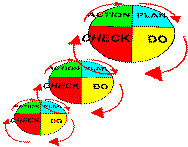Kaizen

|
Kaizen |
|
| Kaizen is simply the Japanese word for improvement. It is composed of two kanji, 'change' and 'better'. Strictly speaking, kanji are ideograms rather than 'words', so if we simply translate 'kaizen' as 'improvement' some of the ideas get lost. |  |
| Kaizen was introduced to the UK when NMUK (Nissan Motor Manufacturing UK) was established in the mid eighties. Initial recruits had been to Japan to learn their jobs, and they found that as their skills improved their hosts acknowledged their efforts with smiles and comments of 'Kaizen!' They came to learn that kaizen was not simply something required to reach an acceptable level of performance in the workplace, but something that was expected to keep on applying in order to make things better and better. |
| The Japanese view was that
improvement in the workplace was not simply the responsibility of
specialists or engineers, but that everybody had a duty to improve for the
benefit of themselves, their colleagues and the company as a whole.
Indeed, kaizen was deemed so important that it was attributed as the main
reason for Japan's competitive
success!
On successive visits to Japan, NMUK personnel saw how manufacturing performance just kept on improving. They noted several aspects to spirit of kaizen: |
Masaaki Imai, originally of the Cambridge Corporation, used to arrange visits for Japanese industrialists to learn what they could in the USA. By the late seventies he noticed that the trend was reversing - Americans were wanting to know how the Japanese were becoming so successful! He subsequently wrote 'Kaizen, the Key to Japan's Competitive Success' and established the Kaizen Institute. |
|
'Making a plan - and sticking to it', 'Taking lots of small steps, one at a time, rather than shooting for the moon', 'Paying attention to detail', 'Making use of data and statistics'.
|
|
Kaizen was undertaken in three main ways in
the workplace (Japanese: 'genba' or 'gemba'). There was:
|
||
| As soon as NMUK was up and running, there
was an enthusiasm for establishing QCC activity. However - it was pointed
out that the first priority was to
actually make and sell motor cars - kaizen could wait!
This was a significant point: establish standards first - then improve on them! This lesson continues to be overlooked - people are anxious to improve, yet they often have no established foundations to build upon!
|
| After a couple of years, NMUK staff
had been able to understand, through doing for themselves, what
elements of Japanese and western methods
worked best. They had established their
own standard ways of doing things. The time had come for improvement
groups!
'Quality Circles' had been introduced to the UK in the early eighties, with generally disappointing results. Rather than simply adopt QCCs at NMUK, the topic was researched in order to understand the key elements for success, and reasons for failure. It was found that NMUK had already established many of the pre-requisites, but there were some things that needed to be established or re-enforced.
|
| Each of these steps had appropriate tools and/or techniques in order to provide a clear framework for activity. Teams could chose whether or not they should use them, as appropriate to the activity. |
|
|
12. FURTHER IMPROVEMENT | |||||||||||
| 11. REVIEW THE PROCESS | ||||||||||||||
| 10. STANDARDISE CHANGES | ||||||||||||||
| 9. CONDUCT TRIALS | ||||||||||||||
| 8. PLAN TRIALS | ||||||||||||||
| 7. CONSIDER SOLUTIONS |  |
|||||||||||||
| 6. ANALYSE DATA | ||||||||||||||
| 5. GATHER DATA | ||||||||||||||
| 4. PLAN ACTIVITY | The steps were based on the never-ending 'PDCA' cycle | |||||||||||||
| 3. SET TARGETS | ||||||||||||||
| 2. GIVE REASONS | ||||||||||||||
| 1. SELECT THEME | ||||||||||||||
|
Kaizen activities and a 'kaizen attitude' have had a significant part to play in the way NMUK conducts it's business. Kaizen is an essential element of genba kanri which has, in turn, been the key to NMUK becoming by far the most productive automotive plant in Europe. |
|
It may be tempting to summarise kaizen as 'continuous improvement' - but to do so may be to dismiss much of the essence of kaizen. Key features to remember are:
|
|
...one final Japanese word: Gambatte! - go for it! |
|
GENBA KANRI: The web site dedicated to improving manufacturing competitiveness |
|
|
genba-kanri.com |